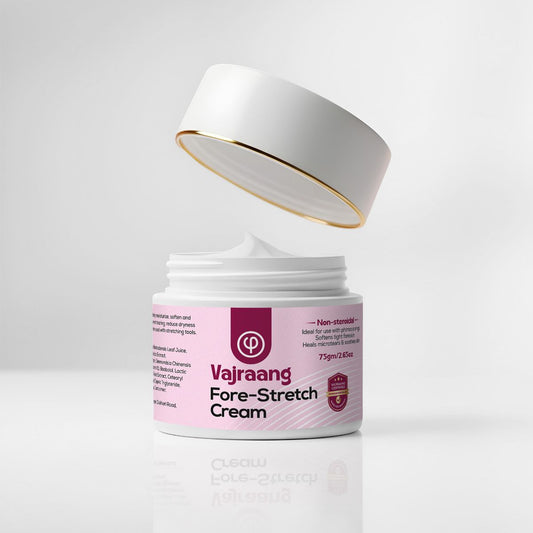If you’ve been diagnosed with phimosis, identifying the severity of your condition is essential for tailoring an effective treatment plan. Phimosis, characterized by a tight foreskin that cannot retract over the glans, varies in severity from mild to severe. Understanding your stage will help you choose the right tools, techniques, and steps to progress confidently toward full foreskin mobility.
Stage 1: Pinhole Phimosis (Diameter Up to 4mm)
This is the most severe stage, where the foreskin opening is as narrow as a pinhole, making retraction impossible, even when flaccid.
Challenges:
• Ballooning during urination.
• Restricted sexual pleasure due to limited foreskin movement.
• Longer treatment timeline.
Steps to Address:
1. Start with gentle manual stretching using a Q-tip wrapped in soft tape to carefully widen the phimotic band.
2. Progress to the smallest size of the Vajraang Phimosis Stretching Rings for gradual improvement.
3. Use Vajraang Extra Virgin Coconut Oil to reduce friction and enhance comfort.
Learn more about severe cases like pinhole phimosis in “How to Treat Pinhole Phimosis Effectively”.
Stage 2: Glans Partially Visible (Diameter 5–18mm)
At this stage, the foreskin can partially retract but cannot move past the glans’ ridge (corona).
Challenges:
• Over-sensitivity of the glans.
• Pain or tearing during intimacy.
• Limited access for proper hygiene.
Steps to Address:
1. Use a snug-fitting Vajraang Phimosis Ring paired with manual stretching.
2. Lubricate with Vajraang Extra Virgin Coconut Oil to enhance comfort and flexibility.
3. Gradually increase stretching sessions for consistent improvement.
For additional guidance on managing glans sensitivity, visit “How to Overcome Phimosis Challenges During Intimacy”.
Stage 3: Foreskin Retracts Behind Corona When Flaccid (Diameter 18–26mm)
At this stage, retraction is possible when flaccid but remains tight during an erection.
Challenges:
• Risk of paraphimosis (foreskin trapped behind the glans).
• Persistent glans sensitivity adjusting to exposure.
• Hygiene requires consistency.
Steps to Address:
1. Combine phimosis rings with two-finger stretching for added flexibility.
2. Apply Vajraang Phimosis & Paraphimosis Cream to improve elasticity and reduce irritation.
3. Gradually expose the glans to warm water for desensitization.
4. Use condoms during intimacy to avoid paraphimosis and discomfort.
Learn how to prevent complications in “Preventing Paraphimosis and Tears During Phimosis Treatment”.
Stage 4: Foreskin Retracts Freely to Corona When Erect (Diameter 26–34mm)
At this stage, the foreskin retracts easily to the ridge of the glans during an erection but may still feel tight for full retraction.
Challenges:
• Persistent tightness near full retraction.
• Reduced but present risk of paraphimosis.
Steps to Address:
1. Use larger Vajraang Phimosis Rings consistently to achieve full retraction.
2. Stretch after a warm bath for easier tissue expansion.
3. Maintain proper lubrication with Vajraang Extra Virgin Coconut Oil.
Stage 5: Mild Phimosis (Diameter 34mm and Upwards)
At this mildest stage, full retraction is possible during an erection but may still feel slightly tight.
Challenges:
• Minor tightness during sexual activity.
• Low risk of paraphimosis.
Steps to Address:
1. Use the largest Vajraang Phimosis Rings for maintenance.
2. Incorporate regular stretching as a preventive measure.
3. Continue good hygiene habits with Phimosis Intimate Wash.
Stage 0: Fully Normal Foreskin
At this stage, the foreskin retracts smoothly in both flaccid and erect states without tightness or discomfort.
Next Steps:
• Occasionally use the largest ring to lock in progress.
• Practice regular cleaning and lubrication to maintain foreskin health.
Why Understanding Your Stage Matters
Knowing your phimosis stage helps you:
• Select the right tools and techniques.
• Track milestones and progress.
• Approach treatment with confidence and clarity.
Final Thoughts
Phimosis is not permanent—it’s a manageable condition that thousands overcome with consistent effort and the right tools. Whether you’re addressing pinhole phimosis or refining mild tightness, Vajraang Phimosis Stretching Rings and Vajraang Phimosis & Paraphimosis Cream offer a proven path to success.
Progress may feel gradual, but each step brings you closer to comfort, confidence, and full mobility. Start your journey today—your results are within reach!





